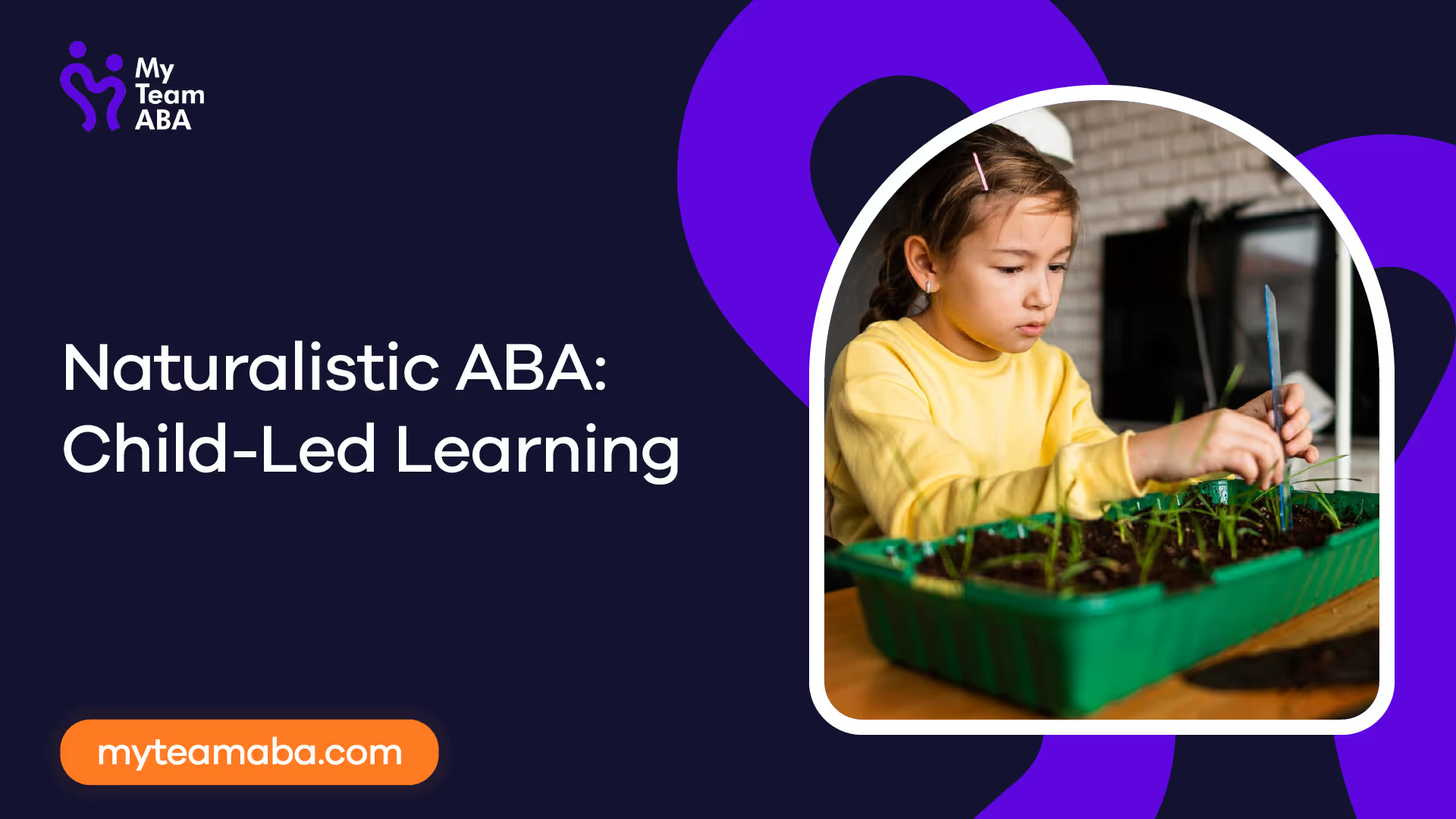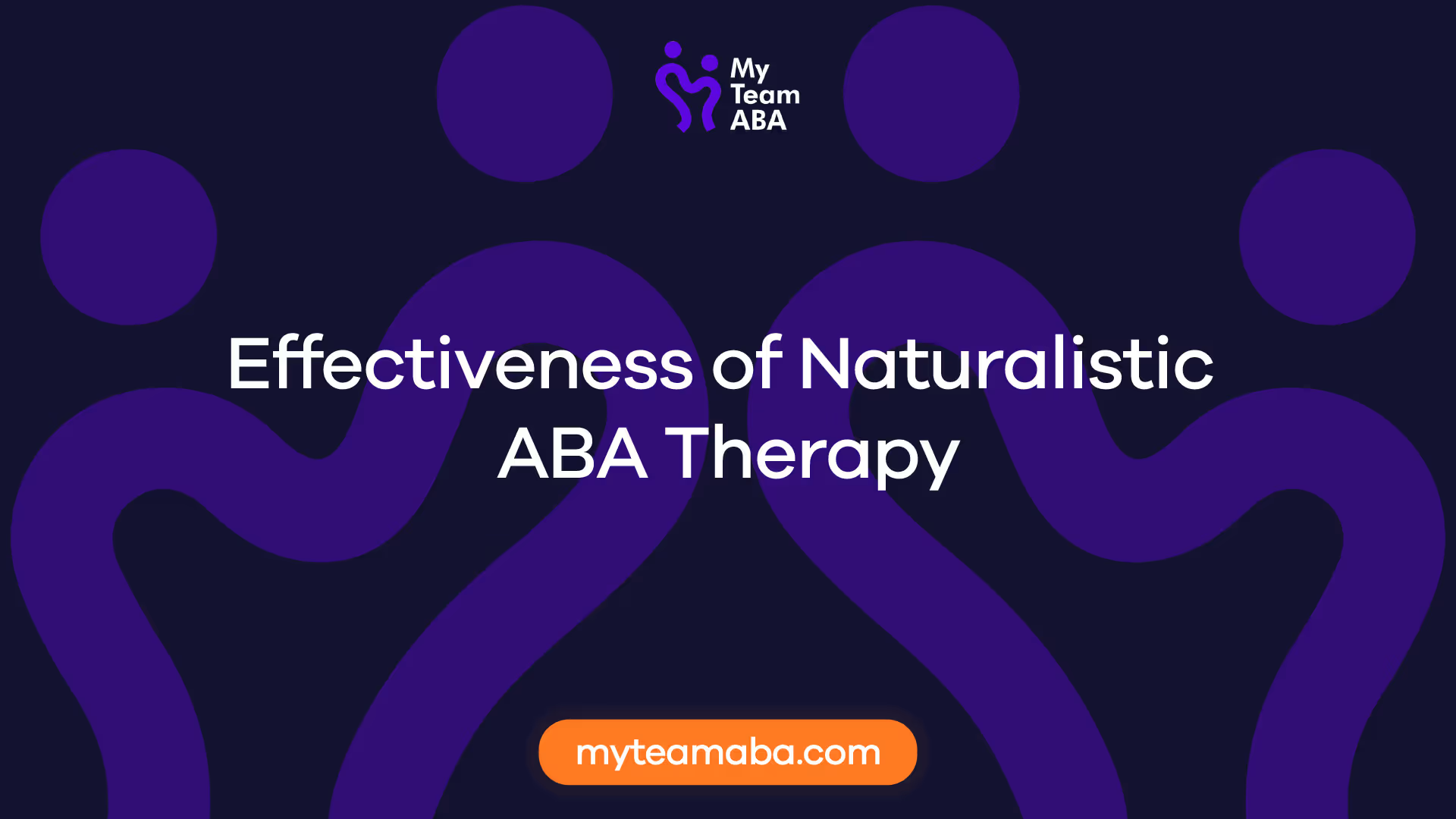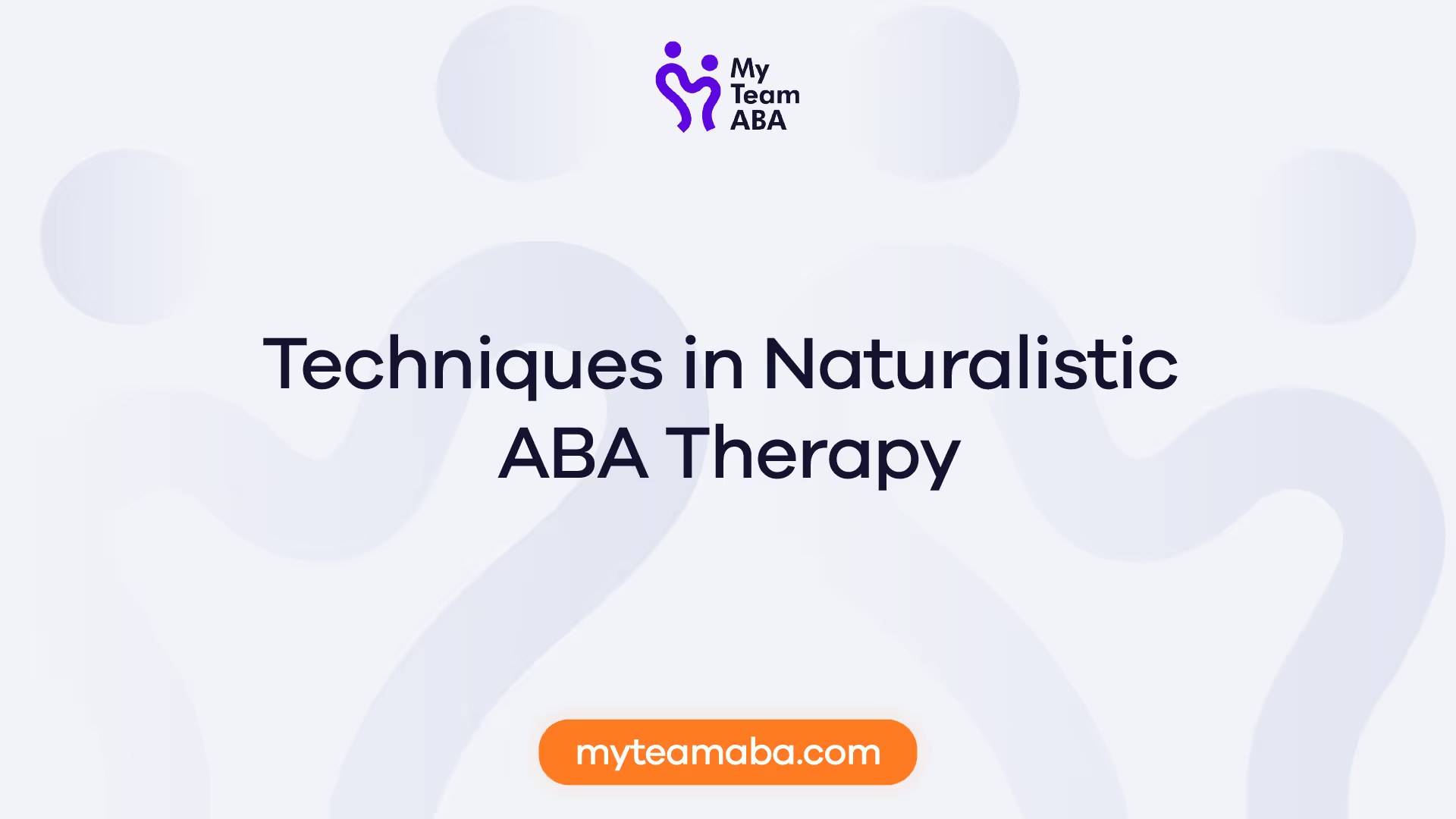Naturalistic ABA: Child-Led Learning
March 2, 2025
Unlock the power of child-led learning with naturalistic ABA therapy. Discover the advantages and effectiveness for skill development.


Understanding Naturalistic Teaching Strategies
In the realm of Applied Behavior Analysis (ABA), naturalistic teaching strategies have emerged as an effective approach for promoting the development of children with autism spectrum disorders (ASD) and other developmental disabilities. These strategies capitalize on the children's natural interests and routines, creating a learning environment that is both engaging and meaningful to the child.
Definition and Purpose
Naturalistic teaching strategies, also known as natural environment training (NET), aim to foster language, social, and cognitive development by incorporating the child's natural interests and motivations into the learning process. This approach recognizes that learning is most effective when it is relevant and meaningful to the learner.
By utilizing the principles of operant conditioning, naturalistic teaching strategies focus on reinforcing desired behaviors while redirecting or ignoring undesired behaviors. The therapist follows the child's lead, allowing them to initiate activities, and then provides guidance and reinforcement to help them achieve their goals [2]. This child-led approach creates a more natural and enjoyable learning experience.
Importance of Play
Play is a fundamental component of naturalistic teaching strategies for children with developmental disabilities. Through play, children are able to explore their environment, learn new skills, and engage in social interactions with their peers and adults. Play provides a context for children to practice and generalize skills in a natural and enjoyable manner.
In naturalistic teaching, play is leveraged as a powerful tool for learning. By incorporating play into therapy sessions, therapists can capture the child's attention and motivation, making the learning experience more engaging and meaningful. Play-based activities allow children to practice a wide range of skills, such as communication, problem-solving, and social interaction, in a natural and enjoyable context.
By embracing naturalistic teaching strategies and recognizing the importance of play, therapists and educators can create a learning environment that is tailored to the child's individual needs and interests. This child-led approach helps to foster a love for learning and promotes the development of crucial skills in a way that is natural and enjoyable.
As we continue to explore the effectiveness and benefits of naturalistic teaching strategies, it becomes clear that this approach holds great potential for supporting the growth and development of children with autism spectrum disorders and other developmental disabilities. By capitalizing on the child's natural interests and routines, naturalistic teaching strategies can unlock their potential and promote meaningful learning experiences.

Effectiveness of Naturalistic ABA Therapy
Naturalistic ABA (Applied Behavior Analysis) therapy, specifically child-led learning, has been proven to be effective in promoting the development of children with autism spectrum disorders (ASD) and other developmental disabilities. This section will explore the advantages of naturalistic ABA therapy over traditional methods and highlight the importance of individualization and personalization in this approach.
Advantages Over Traditional Methods
Naturalistic ABA therapy offers several advantages over traditional teaching methods, such as discrete trial training (DTT) or structured teaching approaches. By capitalizing on the child's natural interests and routines, naturalistic ABA therapy creates a more engaging and motivating learning environment. This approach focuses on the child's preferences, allowing them to take the lead in their learning journey, resulting in increased participation and motivation.
Compared to traditional methods that often involve repetitive drills, naturalistic ABA therapy promotes learning within meaningful contexts. By embedding teaching opportunities in everyday activities and play, this approach enhances generalization of skills. Children are more likely to apply the skills they learn in therapy sessions to real-life situations, facilitating a smoother transition from therapy to the natural environment.
Individualization and Personalization
One of the key strengths of naturalistic ABA therapy is its emphasis on individualization and personalization. Each child has unique strengths, challenges, and interests. Naturalistic ABA therapy recognizes and respects these individual differences, tailoring interventions to meet the specific needs of each child.
By observing and understanding the child's natural interests, therapists can identify effective teaching opportunities that align with the child's preferences. This personalized approach enhances engagement and motivation, making learning more enjoyable and effective. As a result, children are more likely to acquire and generalize new skills, such as communication, social interactions, and problem-solving abilities.
The individualization and personalization of naturalistic ABA therapy extend beyond the therapy sessions. Family involvement plays a crucial role in the child's progress. Parents and caregivers are encouraged to participate in therapy sessions, learn the techniques, and apply them in daily routines and interactions. This collaborative approach ensures continuity and maximizes the child's learning opportunities.
In conclusion, naturalistic ABA therapy provides distinct advantages over traditional teaching methods. By capitalizing on the child's natural interests and routines, this approach creates a more engaging and motivating learning environment. The individualization and personalization of interventions further enhance the child's progress and promote the generalization of skills. With its focus on child-led learning, naturalistic ABA therapy offers a promising approach for promoting the development of children with ASD and other developmental disabilities.

Techniques in Naturalistic ABA Therapy
Naturalistic ABA therapy employs various techniques to promote child-led learning and facilitate skill development. These techniques focus on creating a natural and engaging learning environment for children. Three key techniques used in naturalistic ABA therapy are Pivotal Response Training (PRT), Incidental Teaching, and the Natural Language Teaching Paradigm (NLP).
Pivotal Response Training (PRT)
Pivotal Response Training (PRT) is a naturalistic instructional technique in ABA therapy that targets pivotal areas of a child's development, such as motivation, response to multiple cues, self-regulation, and initiation of social interactions. PRT aims to strengthen a child's drive to learn, enhance communication skills, and improve behavior.
Through PRT, therapists create a supportive and motivating environment where the child takes an active role in their learning. The technique utilizes child-initiated activities and interests to encourage spontaneous communication and interaction. PRT emphasizes natural reinforcers tied to the activity itself, promoting the child's engagement and motivation. This approach enhances the child's overall communication skills and fosters generalization of learned behaviors to various settings.
Incidental Teaching
Incidental Teaching is a naturalistic instructional technique that capitalizes on a child's spontaneous interests and actions. This technique follows the child's lead and adapts to their natural environment and interests. Incidental Teaching provides learning opportunities by embedding instructional moments within the child's ongoing activities and play.
During Incidental Teaching, therapists use cues and prompts to guide the child's behavior and encourage communication and skill development. By following the child's lead, therapists can identify and address specific learning objectives in a meaningful and contextualized manner. This technique enhances the child's motivation, engagement, and learning outcomes.
Natural Language Teaching Paradigm (NLP)
The Natural Language Teaching Paradigm (NLP) is a naturalistic instructional technique in ABA therapy that creates a language-rich environment to promote language development and communication skills. NLP arranges the environment to provide more opportunities for the child to use language skills.
In NLP, therapists focus on the child's initiative and capitalize on their interests to encourage natural communication. The technique emphasizes the use of inherent reinforcers tied to the activity itself, making the learning experience enjoyable and meaningful for the child. By creating a language-rich environment, NLP facilitates the development of expressive and receptive language skills in a natural and contextually relevant manner.
These techniques in naturalistic ABA therapy, including Pivotal Response Training (PRT), Incidental Teaching, and the Natural Language Teaching Paradigm (NLP), provide effective ways to enhance child-led learning, promote skill development, and foster positive outcomes in children with autism spectrum disorder. By utilizing these techniques, therapists can create engaging and individualized learning experiences that align with the child's interests and strengths.
Implementation of Naturalistic ABA Therapy
To effectively implement Naturalistic ABA therapy, it is important to consider the role of family involvement and the settings in which the therapy can be applied. These factors play a crucial role in creating a supportive and conducive environment for child-led learning.
Family Involvement
One of the key advantages of naturalistic ABA therapy is its family-friendly nature. Family members can play an active role in the therapy, as it is a simple method that can be used almost anywhere. Therapists can provide basic training to family members, empowering them to incorporate naturalistic teaching strategies at home. By involving the family, the child benefits from consistent support and reinforcement across different environments, leading to improved generalization of skills.
Incorporating naturalistic ABA techniques into daily routines and activities allows for continuous learning opportunities. For example, during mealtime, parents can encourage communication and social skills by creating opportunities for the child to request food or engage in conversation. Family members can also provide positive reinforcement and praise when the child demonstrates desired behaviors, reinforcing their learning experience.
Settings for Application
Naturalistic ABA therapy can be implemented in various settings where a child spends time, such as homes, schools, and therapy centers. Parents, caregivers, therapists, and teachers all play a role in creating a supportive environment for the child's learning and development. By implementing naturalistic ABA techniques across different settings, the child has the opportunity to practice and generalize skills in real-life situations [6].
At home, parents can create a structured yet flexible environment that encourages the child's independence and engagement in various activities. By incorporating naturalistic teaching strategies during playtime, mealtime, and daily routines, parents provide consistent opportunities for the child to learn and practice new skills.
In school and therapy centers, therapists and teachers can incorporate naturalistic ABA techniques into structured learning activities. By creating an inclusive and supportive learning environment, children can develop and generalize skills across different contexts. Collaboration between therapists, teachers, and parents is essential for consistent implementation and reinforcement of naturalistic ABA strategies.
By actively involving family members and utilizing different settings, naturalistic ABA therapy maximizes opportunities for learning and skill development in the child's natural environment. This approach promotes the generalization of skills and enhances the child's ability to apply learned behaviors to real-life situations. Through active collaboration and consistent implementation, the potential for progress and growth is enhanced.
Research and Evidence
When it comes to naturalistic ABA therapy, there is growing evidence to support its effectiveness in promoting the development of various skills in children, particularly those with Autism Spectrum Disorder (ASD) and other developmental disabilities. Let's explore the studies conducted on the effectiveness of naturalistic ABA therapy and its impact on skill development.
Studies on Effectiveness
Recent research has shown that naturalistic teaching strategies, such as those used in naturalistic ABA therapy, are more effective than traditional teaching methods in promoting language development, social skills, and cognitive abilities in children with ASD and other developmental disabilities. These studies have provided valuable insights into the benefits of child-led learning and the positive outcomes it can have on skill acquisition.
One of the advantages of naturalistic ABA therapy is its focus on real-world learning experiences. This approach allows children to learn in natural settings and apply the skills they acquire in their daily routines. Research has shown that this naturalistic approach improves the generalization of skills, enabling children to transfer what they have learned to different situations and environments [5].
Impact on Skill Development
Naturalistic ABA therapy has been found to have a positive impact on various areas of skill development. By incorporating play and child-led activities, this therapy approach promotes the development of communication skills, social interactions, and problem-solving abilities in children with ASD [1]. The emphasis on natural settings and everyday activities allows children to learn and practice these skills in meaningful contexts, enhancing their ability to generalize and apply them in real-life situations.
Furthermore, naturalistic ABA therapy takes advantage of naturally occurring reinforcement during a child's daily activities, making learning enjoyable and engaging. By teaching through play and accessing naturally reinforcing activities, therapists can effectively reinforce desired behaviors and promote skill acquisition [5]. This approach not only enhances learning outcomes but also fosters a positive and family-friendly therapy experience.
As the research on naturalistic ABA therapy continues to evolve, it is becoming increasingly clear that this child-led approach holds significant promise in promoting the development of various skills in children with ASD and other developmental disabilities. By providing a tailored and individualized approach, naturalistic ABA therapy offers a pathway to unlocking the potential of each child and facilitating their growth and independence.
Future of Naturalistic ABA Therapy
As naturalistic ABA therapy continues to evolve, new practices and potential benefits emerge, offering promising prospects for the future.
Evolving Practices
One of the key aspects of naturalistic ABA therapy is its adaptability and flexibility. Therapists and researchers are continually exploring innovative techniques and approaches to enhance the effectiveness of this therapy. By incorporating the principles of child-led learning and play, therapists can create individualized treatment plans that cater to the unique needs and interests of each child. This approach fosters a nurturing and engaging environment, promoting optimal learning outcomes.
Advancements in technology have also paved the way for the development of new tools and resources that support naturalistic ABA therapy. These tools aim to enhance learning experiences, facilitate data collection, and provide real-time feedback to therapists and caregivers. With the integration of technology, such as mobile applications and wearable devices, therapy sessions can extend beyond traditional settings, enabling learning opportunities in various everyday situations.
Potential Benefits
The future of naturalistic ABA therapy holds several potential benefits for children with autism spectrum disorder (ASD) and their families. By incorporating naturalistic teaching strategies into daily routines and activities, children can acquire and generalize skills more effectively. This means that the skills learned in therapy sessions can be readily applied in real-life situations, promoting independence and functional abilities.
Family involvement is a crucial aspect of naturalistic ABA therapy, and its significance is expected to grow in the future. Therapists can provide basic training to family members, empowering them to incorporate naturalistic teachings at home. This family-friendly approach allows for continuous learning and reinforcement in a familiar and supportive environment. Families become active participants in their child's progress, promoting consistency and generalization of skills.
Moreover, as naturalistic ABA therapy becomes more widely recognized and accessible, it has the potential to break down barriers and increase awareness about the benefits of child-led learning for individuals with ASD. This recognition can lead to greater acceptance and inclusion in various settings, such as schools, community programs, and social interactions.
By embracing evolving practices and harnessing the potential benefits of naturalistic ABA therapy, the future holds promising opportunities for children with ASD to thrive and reach their full potential. As research and evidence continue to support the effectiveness of this approach, it is an exciting time for the field of naturalistic ABA therapy and the individuals it serves.
